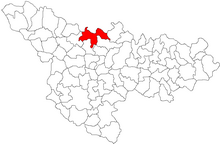Orțișoara
|
Orțișoara Orzydorf Orczyfálva |
||||
|
||||
| Basic data | ||||
|---|---|---|---|---|
| State : |
|
|||
| Historical region : | Banat | |||
| Circle : | Timiș | |||
| Coordinates : | 45 ° 58 ' N , 21 ° 12' E | |||
| Time zone : | EET ( UTC +2) | |||
| Height : | 128 m | |||
| Area : | 143.23 km² | |||
| Residents : | 4,190 (October 20, 2011) | |||
| Population density : | 29 inhabitants per km² | |||
| Postal code : | 307305 | |||
| Telephone code : | (+40) 02 56 | |||
| License plate : | TM | |||
| Structure and administration (as of 2016) | ||||
| Community type : | local community | |||
| Structure : | Orțișoara, Călacea , Cornești , Seceani | |||
| Mayor : | Gheorghe-Aleodor Sobolu ( PSD ) | |||
| Postal address : | Str. Principală, no. 209 loc. Orțișoara, jud. Timiș, RO-307305 |
|||
| Website : | ||||
Orțișoara [ or'tsiʃoara ] ( German Orzydorf , Hungarian Orczyfálva ) is a municipality in the Timiș County , in the Banat region , in southwest Romania , exactly halfway between Timișoara and Arad , 25 km north of Timișoara ( Timisoara ).
Neighboring places
| Gelu | Vinga | Șagu |
| Satchinez |

|
Fibiș |
| Hodoni | Sânandrei | Pișchia |
history
A place in the area of today's Orțișoara is documented for the first time in 1318 under the name "Kakat" in the papal tithe registers. On the Mercy map from 1723 to 1725, the "Praedium Kokot" is marked with a post horn at the place where Orțișoara is today.
Orzydorf was settled in 1785 with 200 families, most of whom came from Lorraine , Saarland , Rhineland-Palatinate , Württemberg and Bavaria . The village got its name after Ladislaus Baron Orcy, who was president of the Timisoara camera administration when the village was settled. In Orzydorf, residents of German descent speak a south-west Franconian dialect. Orzydorf was a cameral property from 1785 to 1836. In 1836 Baron Georg Simon Sina von Hodos and Kizdia acquired the village. After the revolution of 1848/49 , the patrimonial rule was abolished in Orzydorf .
The first school was built in 1785, the first church built in 1809. Up until this point, the service was held in the schoolhouse. Today's Roman Catholic Church was built in 1867.
The Orțișoara municipality includes the villages of Călacea , Cornești and Seceani .
There are three monuments worth mentioning in Orțișoara : the Sacred Heart statue, donated by the Klemens, Leichnam and Weisz families in 1884, the hero monument, donated in 1922 by the "Swabian People's Community" and the Trinity Monument, donated in 1905 by the married couple Johann and Katharina Krepil.
The Treaty of Trianon on June 4, 1920 resulted in the triple division of the Banat , whereby Orișoara fell to the Kingdom of Romania .
In the First World War Ortisoara mourned 75 war victims. A total of 82 soldiers were killed in World War II . On January 15, 1945, 361 men and women from Orțișoara were deported to the Soviet Union for forced labor , of which 70 people never returned. In 1945 the Germans were expropriated in Orțișoara as in all of Romania . In 1948 the industrial, trading and commercial enterprises were nationalized. In 1950, the Agricultural Production Cooperative (LPG) was founded in Orțișoara . In 1958, the Germans were given back their expropriated houses. After the Second World War, the demographic structure of Orțișoara was subject to constant change due to the emigration of Germans.
Demographics
|
|
|
traffic
Orțișoara is on the Timișoara – Arad railway line and Drum național 69 .
See also
literature
- Elke Hoffmann, Peter-Dietmar Leber and Walter Wolf : The Banat and the Banat Swabians. Volume 5. Cities and Villages , Media Group Universal Grafische Betriebe Munich, Munich 2011, ISBN 3-922979-63-7 .
Web links
- Web presentation of the hometown community Orzydorf
- Orțișoara in the Timiș County Council's web presentation
Individual evidence
- ↑ 2011 census in Romania ( MS Excel ; 1.3 MB)
- ↑ Mayoral elections 2016 in Romania ( MS Excel ; 256 kB)




